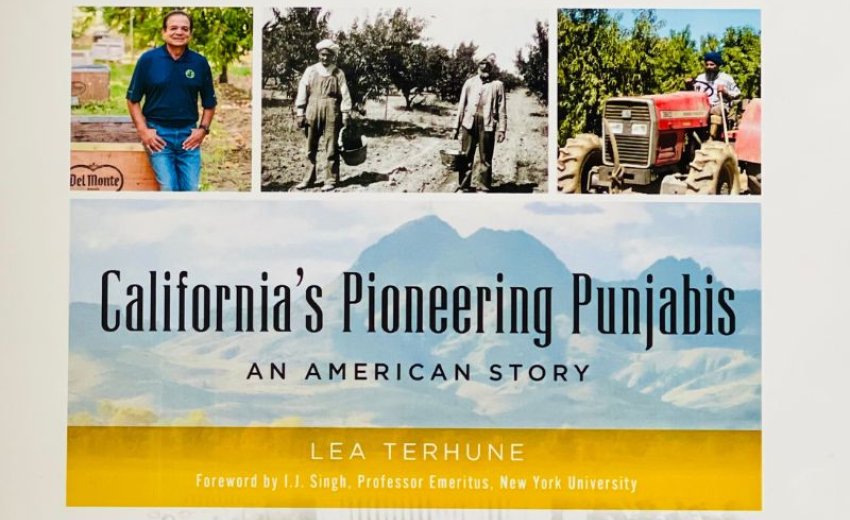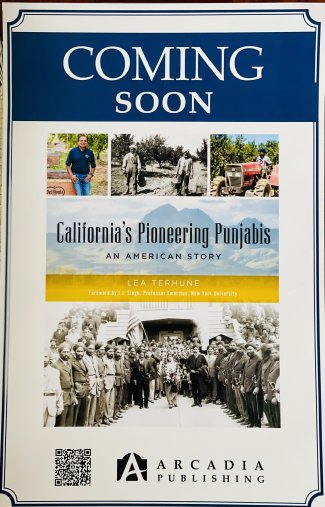In her comprehensive work California’s Pioneering Punjabis: An American Story (The History Press), author Lea Terhune presents the heroic odyssey of the pioneer Punjabis who arrived in California during the closing years of the19th century and through the length of the 20th century, lacing the narrative with historic never-before-seen photographs.Insert
The California Gold Rush of 1848 put California on the world map for the first time and though the Gold Rush dissipated by the mid 1850s, California came to acquire the image of the metaphorical land of gold, where all dreams, big and small, could be fulfilled, attracting hundreds of thousands of people to its shores. The promise of California was not lost on the Punjabis who responded to the California Dream with zest, taking perilous journeys across two oceans to reach the coast of dreams, transforming their lives as well as the golden land with their relentless hope. Early Punjabi pioneers who sailed to California represented a cross section of the Punjabi society of the time, but the majority of them were Sikhs. The book captures the formidable social, cultural, economic and racial barriers that the early pioneers had to overcome to achieve their aspirations and establish themselves in their adopted homeland.
Persisting in the face of discrimination, detention and interrogation at the infamous Angel Island Immigration Station, which was located on the San Francisco Bay, the early pioneers made their way into California, working as farmhands. They were paid much less than their European counterparts and often times became victims of racial riots, wherein they were driven away from towns, their belongings destroyed. They persevered in the hostile terrain, working tirelessly across California’s Central Valley and Imperial Valley with the hope of becoming farm owners someday. It was a near impossible dream to be dreaming since the Alien Land Laws of 1913, 1920, and 1923 forbade Punjabi men from attaining American citizenship and buying land. Not ones to buckle in the face of the ruthless racial laws, the Punjabi pioneers devised a way to skirt the laws. They entered into agreements with well-meaning Anglos who agreed to hold the land for the pioneers in their name and more often than not, these agreements were honored. The fact that by the early decades of the 20th century, Punjabi men were leasing and farming about 300,000 acres in California speaks to the ingenuity and hard work of the early pioneers.
Immigration from India was curtailed when India became part of the Asiatic Barred Zone in 1917 and furthermore by the Immigration Act of 1924. Punjabi men could not travel to India during this time. They craved to build homes and grow roots, so many of them began to marry Mexican women and a beautiful bi-ethnic, secular Punjabi-Mexican community sprang up in California which lasted until 1946, when the Lucy Cellar Act granted the Punjabi pioneers the right to citizenship, paving the way for them to return to India and bring brides.
The book showcases the legendary stories that inform the California travails of the early Punjabi pioneers. From the iconic feat of Ghadhar activist Kartar Singh Sarabha and the symbolic resistance of Bhagat Singh Thind to the impassioned anti-racist protest of Pakhar Singh Gill and the landmark achievement of the first Asian Congressman Dalip Singh Saund, the book pays a glorious tribute to the invincible spirit of California’s Punjabi pioneers, who became beacon lights for not just Indians but all Asians.
The book also throws spotlight on contemporary Punjabi trailblazers who continue to invigorate the California story with their pioneering achievements in science, medicine, engineering, farming, entrepreneurship and philanthropy. The book is the outcome of methodical research done over many years and the author acknowledges the members of the Punjabi-American Society of Yuba City – Jasbir S. Kang, Davinder K. Deol, Hitpal S. Deol, Sarabjit S. Johl, Kulwant S. Johl and Gurmit K. Sidhu for providing her with many significant details and photographs. The book is a celebration of the epochal journey of California’s pioneering Punjabis, offering a one-of-a-kind diaspora narrative of trial, tribulation and fantastic success.
You can purchase the book here : http://pahsbook.com/
About the reviewer
Simrita Dhir is a California-based academic and novelist. She has a PhD in American Literature from the Department of English and Cultural Studies, Panjab University, Chandigarh. She lectures on Writing, Diversity, and Imagination. Her critically acclaimed novel “The Rainbow Acres” captures the strife, struggle, and fantastic success of the pioneer Punjabi farmers who set sail for California in the early 20th century in quest of land and identity.


